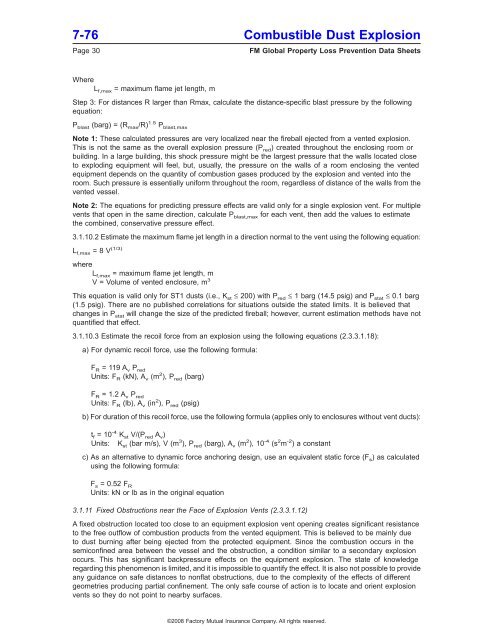DS 7-76 Prevention and Mitigation of Combustible Dust ... - FM Global
DS 7-76 Prevention and Mitigation of Combustible Dust ... - FM Global
DS 7-76 Prevention and Mitigation of Combustible Dust ... - FM Global
You also want an ePaper? Increase the reach of your titles
YUMPU automatically turns print PDFs into web optimized ePapers that Google loves.
7-<strong>76</strong> <strong>Combustible</strong> <strong>Dust</strong> Explosion<br />
Page 30 <strong>FM</strong> <strong>Global</strong> Property Loss <strong>Prevention</strong> Data Sheets<br />
Where<br />
L f,max = maximum flame jet length, m<br />
Step 3: For distances R larger than Rmax, calculate the distance-specific blast pressure by the following<br />
equation:<br />
P blast (barg) = (R max/R) 1.5 P blast,max<br />
Note 1: These calculated pressures are very localized near the fireball ejected from a vented explosion.<br />
This is not the same as the overall explosion pressure (P red) created throughout the enclosing room or<br />
building. In a large building, this shock pressure might be the largest pressure that the walls located close<br />
to exploding equipment will feel, but, usually, the pressure on the walls <strong>of</strong> a room enclosing the vented<br />
equipment depends on the quantity <strong>of</strong> combustion gases produced by the explosion <strong>and</strong> vented into the<br />
room. Such pressure is essentially uniform throughout the room, regardless <strong>of</strong> distance <strong>of</strong> the walls from the<br />
vented vessel.<br />
Note 2: The equations for predicting pressure effects are valid only for a single explosion vent. For multiple<br />
vents that open in the same direction, calculate P blast,max for each vent, then add the values to estimate<br />
the combined, conservative pressure effect.<br />
3.1.10.2 Estimate the maximum flame jet length in a direction normal to the vent using the following equation:<br />
L f,max = 8 V (1/3)<br />
where<br />
L f,max = maximum flame jet length, m<br />
V = Volume <strong>of</strong> vented enclosure, m 3<br />
This equation is valid only for ST1 dusts (i.e., K st ≤ 200) with P red ≤ 1 barg (14.5 psig) <strong>and</strong> P stat ≤ 0.1 barg<br />
(1.5 psig). There are no published correlations for situations outside the stated limits. It is believed that<br />
changes in P stat will change the size <strong>of</strong> the predicted fireball; however, current estimation methods have not<br />
quantified that effect.<br />
3.1.10.3 Estimate the recoil force from an explosion using the following equations (2.3.3.1.18):<br />
a) For dynamic recoil force, use the following formula:<br />
F R = 119 A v P red<br />
Units: F R (kN), A v (m 2 ), P red (barg)<br />
F R = 1.2 A v P red<br />
Units: F R (lb), A v (in 2 ), P red (psig)<br />
b) For duration <strong>of</strong> this recoil force, use the following formula (applies only to enclosures without vent ducts):<br />
t f = 10 -4 K st V/(P red A v)<br />
Units: K st (bar m/s), V (m 3 ), P red (barg), A v (m 2 ), 10 -4 (s 2 m -2 ) a constant<br />
c) As an alternative to dynamic force anchoring design, use an equivalent static force (F s) as calculated<br />
using the following formula:<br />
F s = 0.52 F R<br />
Units: kN or lb as in the original equation<br />
3.1.11 Fixed Obstructions near the Face <strong>of</strong> Explosion Vents (2.3.3.1.12)<br />
A fixed obstruction located too close to an equipment explosion vent opening creates significant resistance<br />
to the free outflow <strong>of</strong> combustion products from the vented equipment. This is believed to be mainly due<br />
to dust burning after being ejected from the protected equipment. Since the combustion occurs in the<br />
semiconfined area between the vessel <strong>and</strong> the obstruction, a condition similar to a secondary explosion<br />
occurs. This has significant backpressure effects on the equipment explosion. The state <strong>of</strong> knowledge<br />
regarding this phenomenon is limited, <strong>and</strong> it is impossible to quantify the effect. It is also not possible to provide<br />
any guidance on safe distances to nonflat obstructions, due to the complexity <strong>of</strong> the effects <strong>of</strong> different<br />
geometries producing partial confinement. The only safe course <strong>of</strong> action is to locate <strong>and</strong> orient explosion<br />
vents so they do not point to nearby surfaces.<br />
©2008 Factory Mutual Insurance Company. All rights reserved.

















